At the core of every living organism lies a profound language—a biological code embedded in the very structure of our cells. This code is known as DNA, or deoxyribonucleic acid. Composed of a series of nucleotides arranged in specific sequences, DNA carries the instructions for building and maintaining life. Every organism, from the simplest bacteria to the most complex humans, relies on this code to function. It is an intricate blueprint, dictating everything from the color of your eyes to how your body processes nutrients and repairs itself after injury.
In this code, there is an extraordinary level of precision. Each cell in the human body contains a complete set of DNA, roughly three billion base pairs long, packed into a microscopic nucleus. This set of instructions is vital for the proper functioning of the body. However, like any system that relies on complex instructions, occasional errors can occur. These errors can sometimes result in genetic disorders, conditions in which there is a problem with the genetic makeup of an individual.
What Are Genetic Disorders?
Genetic disorders are diseases caused by abnormalities in an individual’s DNA. These abnormalities can take many forms, from minor mutations in a single gene to large-scale chromosomal changes that affect entire sets of genes. These disorders can be inherited from parents or occur spontaneously during the formation of the egg or sperm, leading to alterations in the offspring’s DNA.
Genetic disorders can affect many aspects of health. They may impact physical traits, such as height or eye color, or internal systems like metabolism or immune function. In some cases, they may cause severe, life-threatening conditions, while in others, they may lead to milder symptoms that can be managed or treated.
The complexity of genetic disorders is staggering. While some are relatively straightforward, caused by a single faulty gene, others involve intricate interactions between multiple genes and environmental factors. Understanding these disorders requires a look into the molecular structure of DNA and how tiny changes in the genetic code can have profound consequences.
The Basics of DNA and Genes
To fully appreciate the nature of genetic disorders, it’s important to first understand the basics of DNA and genes. DNA consists of two long strands that coil around each other to form a double helix. This structure is made up of four building blocks called nucleotides—adenine (A), cytosine (C), guanine (G), and thymine (T). The sequence of these nucleotides forms the instructions for building proteins, the molecular machines that carry out the functions of the body.
Genes are segments of DNA that contain the instructions for producing specific proteins. Each gene in our DNA is a recipe for creating a particular protein that has a vital function in the body, such as enzymes that break down food or antibodies that fight infections. When a gene is altered, it can affect the protein it codes for, and this change can lead to various health problems.
For example, sickle cell anemia is caused by a mutation in the hemoglobin gene. This mutation alters the structure of hemoglobin, the protein responsible for carrying oxygen in red blood cells. As a result, the red blood cells become rigid and crescent-shaped, leading to blockages in blood flow, pain, and organ damage.
Types of Genetic Disorders
Genetic disorders can be classified based on how the mutation is inherited, and this classification helps in understanding their mechanisms and potential treatments. There are three main types of inheritance patterns: autosomal dominant, autosomal recessive, and X-linked.
Autosomal Dominant Disorders
In autosomal dominant disorders, only one copy of a mutated gene is required for the disease to manifest. This means that an individual with a dominant genetic disorder only needs to inherit one copy of the mutated gene, either from their mother or father, to develop the condition. The gene responsible for these disorders is located on one of the non-sex chromosomes, known as autosomes.
Huntington’s disease is a well-known example of an autosomal dominant disorder. It is caused by a mutation in the HTT gene, which leads to progressive neurodegeneration. Individuals with Huntington’s disease typically experience symptoms such as involuntary movements, cognitive decline, and psychiatric issues. The condition usually appears in mid-adulthood, and because it’s inherited in a dominant pattern, each child of an affected individual has a 50% chance of inheriting the gene.
Autosomal Recessive Disorders
Autosomal recessive disorders occur when both copies of a gene (one from each parent) are mutated. In other words, both parents must carry a defective gene for the child to inherit the disorder. The parents themselves are often carriers, meaning they have one normal copy and one mutated copy of the gene but do not exhibit symptoms of the disease.
Cystic fibrosis is a classic example of an autosomal recessive disorder. It is caused by mutations in the CFTR gene, which affects the production of a protein responsible for regulating the movement of salt and water in cells. This results in the buildup of thick, sticky mucus in various organs, particularly the lungs and digestive system. For a child to inherit cystic fibrosis, both parents must carry a copy of the mutated CFTR gene.
X-linked Disorders
X-linked disorders are caused by mutations in genes located on the X chromosome, one of the two sex chromosomes. Since males have one X and one Y chromosome (XY), they are more likely to express X-linked disorders because they have only one copy of the X chromosome. Females, on the other hand, have two X chromosomes (XX), so they are typically protected from X-linked disorders unless both X chromosomes carry the mutated gene.
Hemophilia is an example of an X-linked disorder. This genetic disorder affects the blood’s ability to clot, leading to prolonged bleeding after injury. Hemophilia A, the most common type, is caused by mutations in the F8 gene, which codes for a protein called factor VIII. Because hemophilia is X-linked, it primarily affects males, while females can be carriers who may pass the mutation to their children.
How Mutations Affect Health
Mutations in DNA can occur for a variety of reasons. They may arise due to errors during cell division, exposure to harmful environmental factors like radiation, or the natural aging process of cells. Mutations can be classified into several types, each with different effects on health.
Point Mutations
A point mutation occurs when a single nucleotide in the DNA sequence is altered. This can result in a change in the protein produced by the gene. If the mutation occurs in a critical part of the gene, it can lead to a malfunctioning protein that causes disease. Point mutations are responsible for many genetic disorders, including sickle cell anemia, which is caused by a single nucleotide change in the hemoglobin gene.
Insertion and Deletion Mutations
Insertion and deletion mutations involve the addition or loss of nucleotides in the DNA sequence. These changes can shift the reading frame of the gene, leading to the production of an entirely different protein. These types of mutations are often more severe than point mutations because they can affect the entire structure of the protein.
For example, Duchenne muscular dystrophy is caused by a deletion in the DMD gene, which codes for a protein called dystrophin. Dystrophin is essential for muscle function, and without it, muscle fibers become damaged, leading to progressive muscle weakness.
Copy Number Variations
In some cases, genetic disorders are caused by the duplication or deletion of large sections of DNA. These changes, known as copy number variations (CNVs), can lead to the loss of important genes or the presence of extra copies of genes, both of which can disrupt normal cellular function.
One example of a genetic disorder caused by CNVs is Williams syndrome, a developmental disorder caused by the deletion of several genes on chromosome 7. Individuals with Williams syndrome often exhibit intellectual disabilities, heart problems, and a characteristic facial appearance.
Environmental Factors and Gene Interactions
While genetic mutations play a central role in genetic disorders, they don’t always operate in isolation. Environmental factors and interactions between genes can also influence the severity and progression of a genetic disorder.
For instance, in conditions like cystic fibrosis, environmental factors such as infections, smoking, and air quality can exacerbate the symptoms of the disease. A person with cystic fibrosis may be more susceptible to respiratory infections, which can cause further lung damage.
In other cases, lifestyle choices such as diet and exercise can help mitigate the effects of genetic conditions. For example, individuals with hereditary predispositions to heart disease can reduce their risk by maintaining a healthy diet and exercising regularly.
Advances in Genetic Research and Treatment
The field of genetics has advanced significantly in recent years, providing new hope for the treatment and management of genetic disorders. One of the most promising developments has been the ability to sequence the entire human genome. The Human Genome Project, completed in 2003, mapped the complete set of human DNA, providing invaluable insights into the genetic basis of health and disease.
Today, scientists are working to identify specific genes associated with a wide range of disorders, and new technologies like CRISPR gene editing hold the potential to correct genetic mutations at the molecular level. In some cases, these technologies could one day offer cures for genetic disorders that were once thought to be untreatable.
Gene therapy, which involves inserting, altering, or removing genes within an individual’s cells to treat disease, is another area of active research. Though still in the experimental stages for many conditions, gene therapy has shown promise in treating disorders like inherited blindness and spinal muscular atrophy.
Genetic Counseling and Prevention
As our understanding of genetic disorders grows, so too does the importance of genetic counseling. Genetic counselors help individuals and families understand their risk for inherited conditions and provide guidance on options for testing, treatment, and prevention.
For many genetic disorders, early detection through genetic testing can lead to better management and improved outcomes. Prenatal testing can also provide valuable information, allowing families to make informed decisions about their pregnancies.
Prevention is another key aspect of genetic healthcare. While we cannot always prevent genetic disorders, lifestyle choices such as a healthy diet, regular exercise, and avoiding environmental toxins can reduce the risk of some conditions or improve the quality of life for those affected.
The Future of Genetic Health
The future of genetic health is filled with exciting possibilities. Advances in gene editing, genomic medicine, and personalized therapies could revolutionize the way we treat and prevent genetic disorders. However, these technologies also raise ethical and societal questions about their use and accessibility.
As science continues to unlock the mysteries of DNA and its impact on health, we are entering an era where genetic disorders may no longer be a life sentence but a challenge we can overcome.






